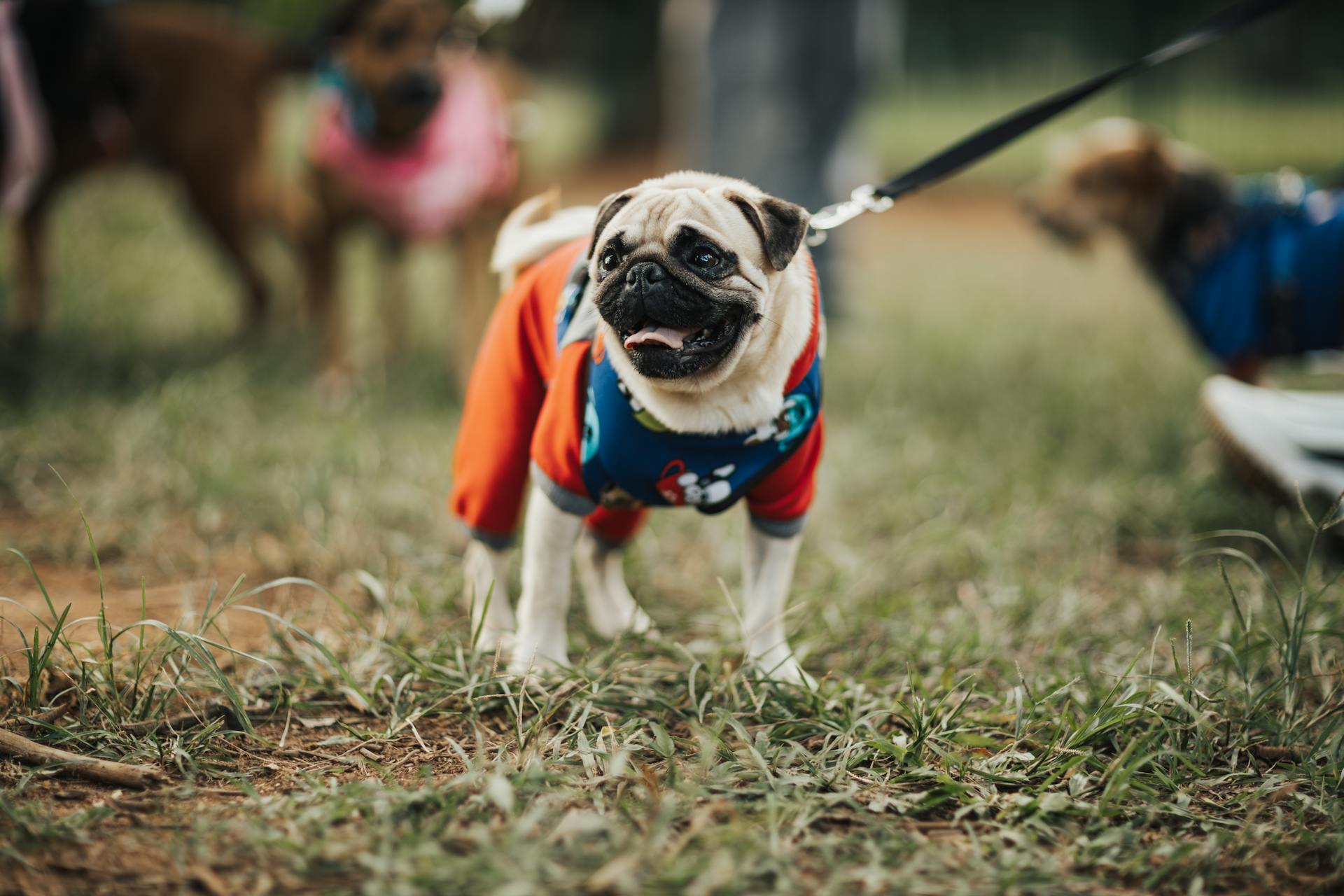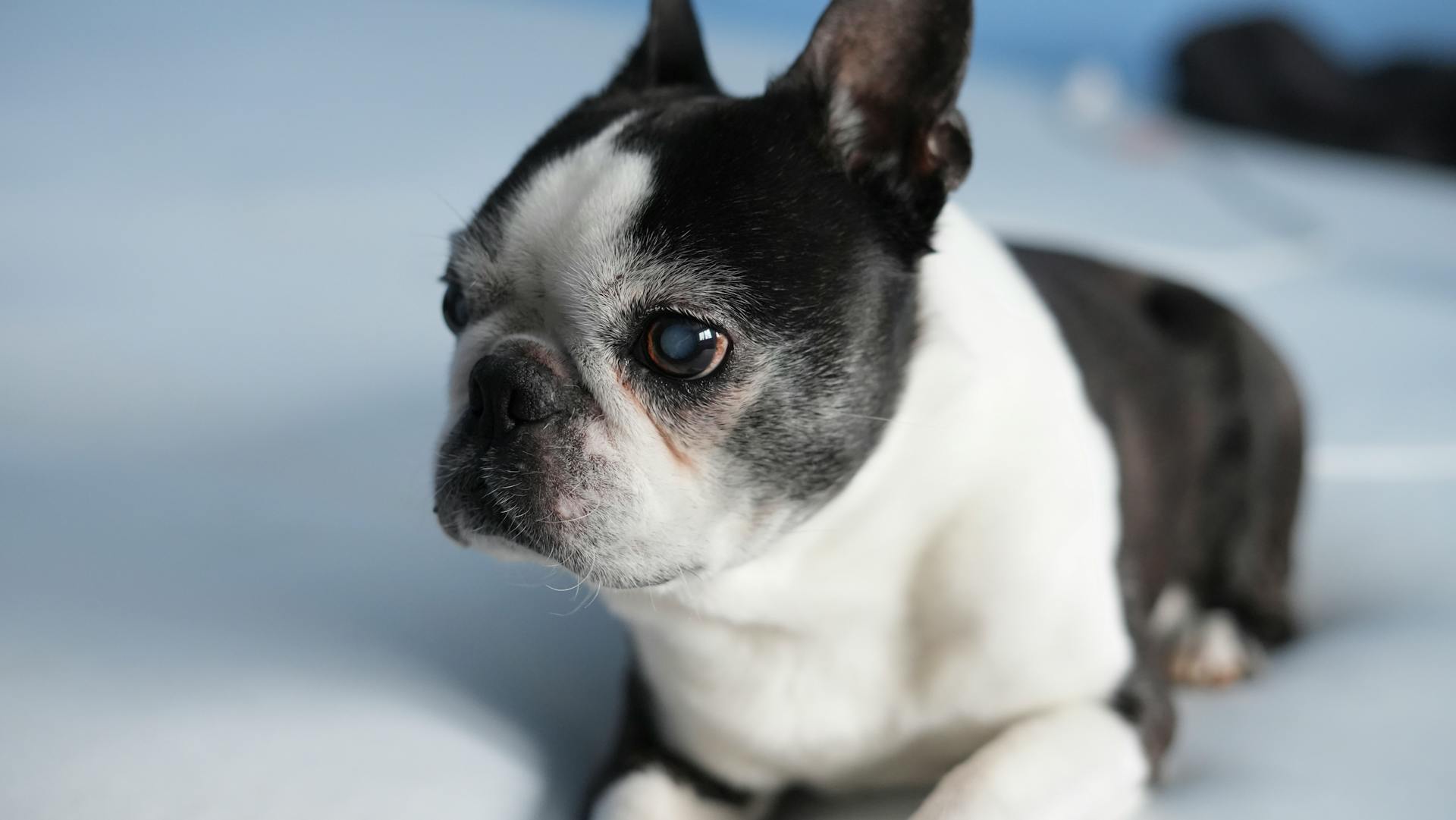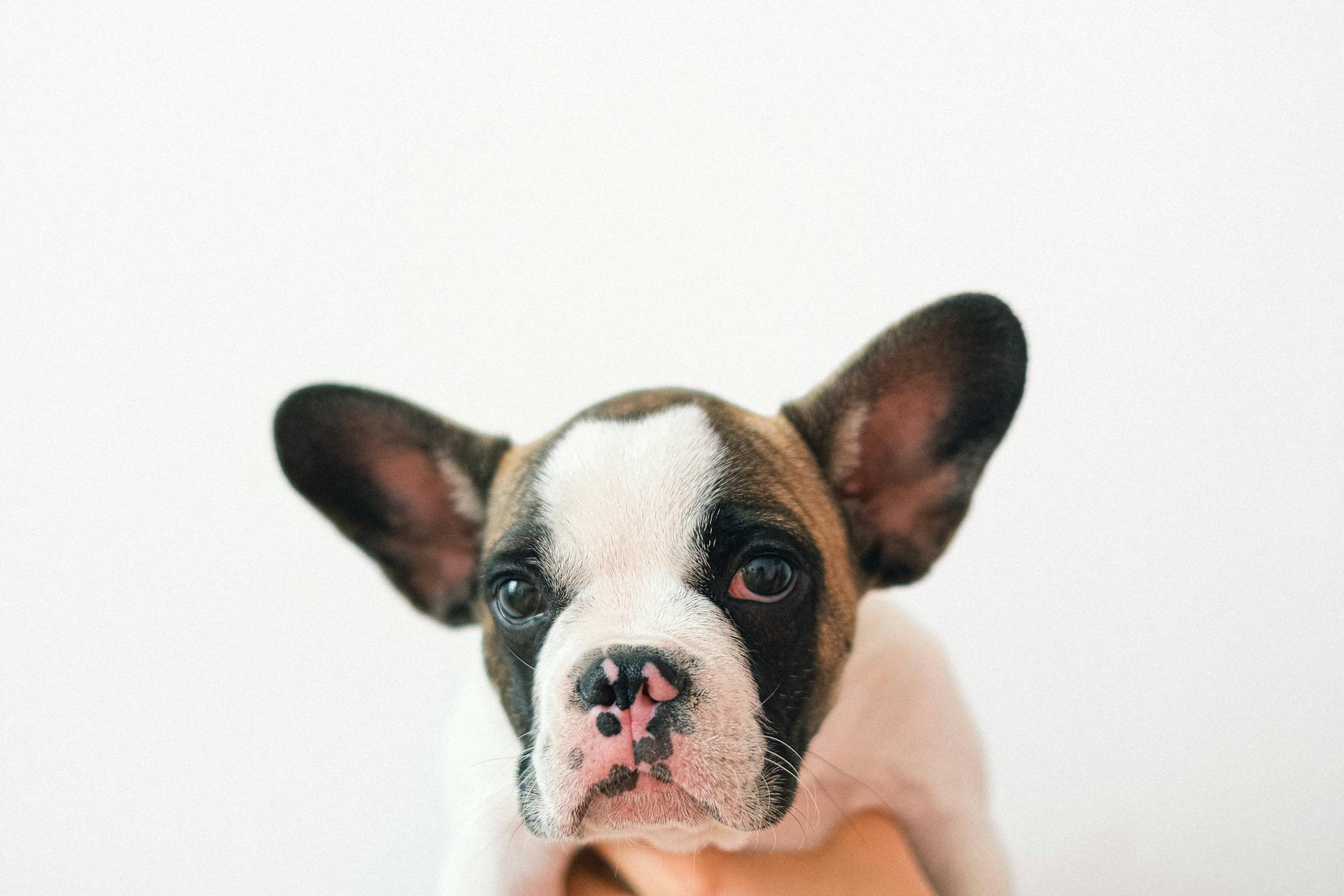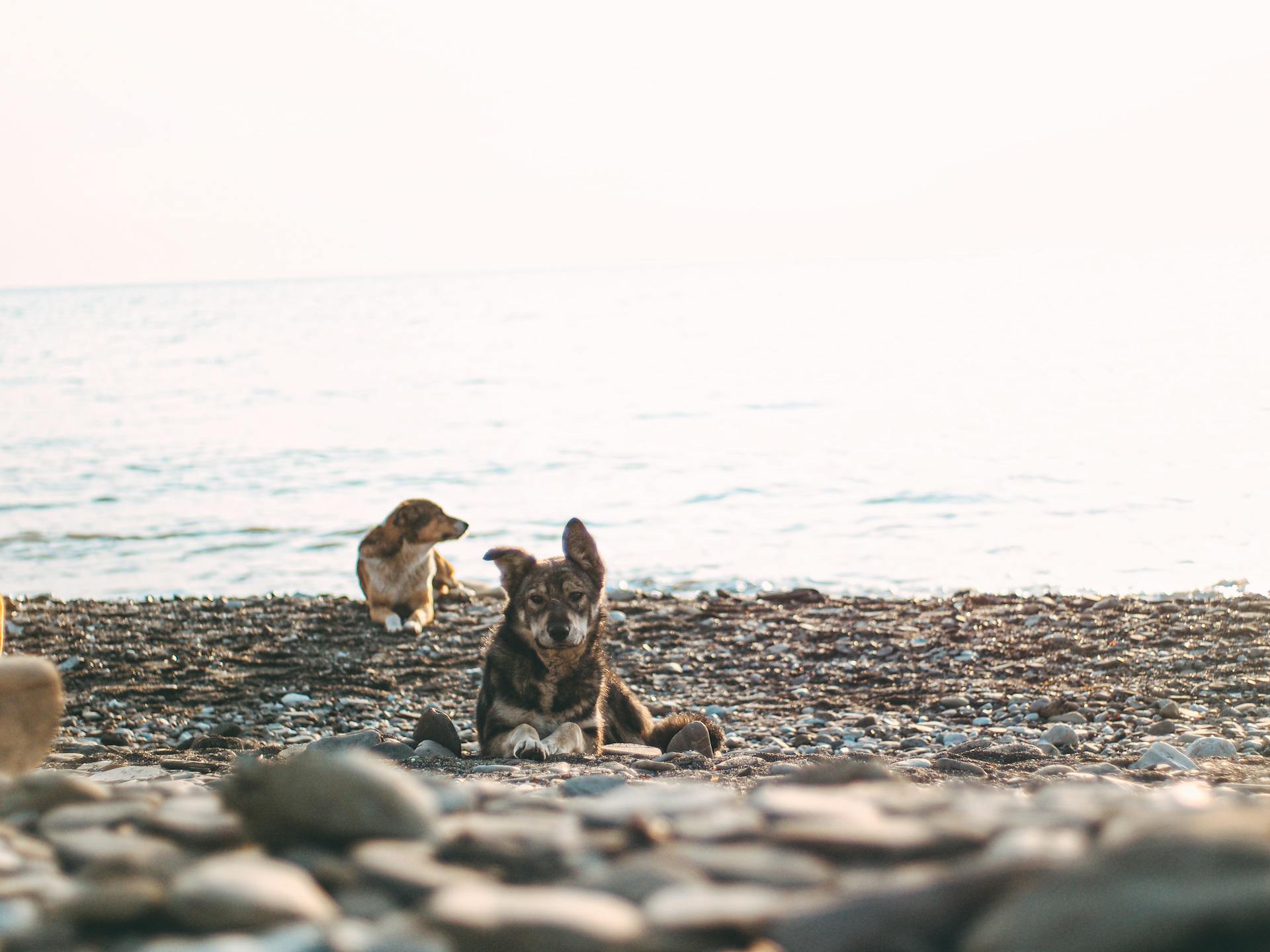
As a puggle owner, you're probably curious about how to keep your furry friend at a healthy weight. Puggles are a cross between a Pug and a Beagle, and their weight can vary depending on their lineage and diet.
Puggles typically weigh between 15-30 pounds, with the average weight being around 20 pounds. This is significantly lighter than the average weight of a Beagle, which can range from 20-35 pounds.
To ensure your puggle is at a healthy weight, it's essential to monitor their food intake and exercise levels. Puggles are prone to obesity, so it's crucial to keep an eye on their diet and make sure they're getting enough physical activity.
A well-balanced diet for puggles should include a mix of protein, fat, and carbohydrates, with a focus on high-quality ingredients like chicken, beef, and sweet potatoes.
On a similar theme: Do Puggle Dogs Shed
Understanding Puggle Weight
Puggles are prone to weight gain, so it's essential to monitor their weight and body condition.
Their ideal weight will fluctuate depending on the season, stress levels, and activity, as well as individual factors.
To determine your Puggle's perfect weight, consider their breed characteristics and consult with your veterinarian.
Your veterinarian will tailor a feeding recommendation to your dog's weight, body condition score, lifestyle, and health needs.
Feeding advice should be taken as guidance, and the best thing you can do is keep a close eye on your Puggle's weight and body condition.
As a general rule, feed your adult Puggle 2% - 3% of their ideal body weight daily.
For example, a Puggle whose ideal weight is 10kg requires around 200g - 300g per day.
You can use a raw dog food calculator to get an estimate for your Puggle.
Factors to consider when determining your Puggle's daily food intake include:
- Amount of exercise
- Weight
- Metabolic rate
- Number of meals per day
- Type of food
Remember to factor in treats when calculating your Puggle's daily calories.
By considering these factors and working with your veterinarian, you can determine the right amount of food for your Puggle to maintain a healthy weight.
Puggle Feeding Guidelines
Puggles are prone to weight gain, so it's essential to feed them the right amount.
Both Beagles and Pugs are active, intelligent breeds that need daily mental and physical stimulation. They're also prone to obesity when left to their own devices.
Feed your adult Puggle two meals a day, one in the morning and one in the evening. Puggle puppies, on the other hand, may require an extra feeding in the middle of the day due to their higher metabolism.
To determine the right amount of food for your Puggle, consider their weight, body condition score, lifestyle, and health needs. You can also consult a veterinarian for personalized advice.
A recommended daily feeding guide is available on the nutrition label of your dog food bag, but this is only a general idea based on your dog's weight.
Treats count, so factor them into your Puggle's daily calories. Overfeeding can lead to health complications, such as obesity and related diseases.
Recommended read: What to Feed a Dog with Kennel Cough

Here's a general rule of thumb for feeding your adult dog: feed 2% to 3% of their ideal body weight daily. For example, a 10kg dog requires around 200g to 300g per day.
To find the ideal body weight for your Puggle, consult with a veterinarian or use a raw dog food calculator. Keep a close eye on your dog's weight and body condition to determine if you're feeding them the right amount.
Factors that affect what type of food to feed your Puggle include their age, weight, and activity level. For instance, puppies need puppy food, while senior dogs may benefit from a senior formula.
Here's a summary of feeding guidelines for Puggles:
Remember, every Puggle is unique, so work with your veterinarian to develop a feeding plan tailored to your dog's needs.
Puggle Growth and Development
At around 1 month old, Puggle puppies typically weigh between 1-2 pounds, growing rapidly to 7-12 pounds by 6 months.
Puggles are prone to overeating and putting on excess weight, so monitoring their food intake closely is crucial. In fact, the American Kennel Club has labeled Pugs as one of the top "chowhound" dog breeds.
By 6 months, Puggles are close to their full adult height, which is typically around 10 to 13 inches tall. To measure your Puggle's height, measure from their footpad to the top of their shoulders while they are standing.
Here's a rough estimate of Puggle growth and weight milestones:
Maintaining a healthy weight is crucial for Puggles to lessen the side effects of brachycephalic syndrome, a common health problem that can cause respiratory distress. A nutritious diet and regular exercise can help keep your Puggle active and living their best life.
As Puggles mature, their nutritional needs change, and their food intake should be adjusted accordingly. Consult your veterinarian to determine the best type of food and how much to feed your Puggle based on their age, weight, and activity level.
Discover more: Puggles
Puggle Care and Nutrition
Caring for a Puggle requires attention to their unique needs, which can be informed by their parent breeds, Pugs and Beagles. Both breeds are playful and even-tempered, with a loving disposition.
Puggles are prone to obesity when left to their own devices, so daily mental and physical stimulation is crucial. A weekly brushing of their short, low-maintenance fur is a great way to spend quality time with your Puggle.
To determine how much to feed your Puggle, work with your veterinarian to consider their weight, body condition score, lifestyle, and health needs. You can also find a recommended daily feeding guide on the nutrition label of your dog food bag.
A Body Condition Score (BCS) can help you assess your Puggle's weight, which is essential for their overall health. A defined waist and visible ribs are signs of a healthy weight.
Pugs are prone to many genetic health problems, including brachycephalic syndrome, which affects their breathing and can lead to heatstroke. Maintaining a healthy weight is crucial to lessening the side effects of this condition.
Consider reading: Boston Terrier Body

Factors that affect what type of food to feed your Puggle include their age, weight, and activity level. For example, puppies need puppy food to support their development, while senior dogs may benefit from a senior formula.
Here are some factors to consider when determining the amount of food to feed your Puggle:
- Amount of exercise
- Weight
- Metabolic rate
- Number of meals per day
- Type of food
By considering these factors and working with your veterinarian, you can ensure your Puggle is receiving the right amount of food for their needs.
Common Issues and Consequences
Overweight Puggles are more prone to diseases such as arthritis, heart and breathing problems, diabetes, and some cancers.
Just like their human owners, Puggles have a shorter lifespan and a reduced quality of life if they're overweight.
Nearly 1 in 2 dogs are overweight or obese, and nearly 1/3 of UK dog owners don't know their dog's current weight.
Recommended read: Awana Puggles
Frequently Asked Questions
Is a Puggle a small or medium dog?
A Puggle is a small to medium-sized dog, suitable for living in a flat or smaller property with outdoor access. Their compact size makes them a great choice for city dwellers or those with limited space.
Sources
- https://www.bellaandduke.com/learn/dog-health/how-much-should-my-dog-weigh/
- https://www.petmd.com/dog/breeds/puggle
- https://spiritdogtraining.com/growth-chart-calculator/beagle/
- https://www.darwinspet.com/blog/blog--feeding-chart-for-dogs-a-complete-guide.html
- https://www.pawlicy.com/blog/pug-growth-and-weight/
Featured Images: pexels.com


